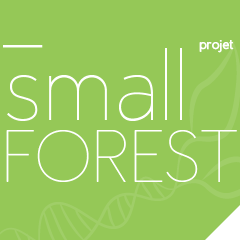 Projet BiodivERsA2011-40
Projet BiodivERsA2011-40
smallFOREST
Biodiversité et services éco systémiques des petits fragments forestiers dans les paysages européens
smallFOREST.fr
Dans la plupart des régions d’Europe, la couverture forestière se présente aujourd’hui sous la forme de petits fragments. Malgré leur petite taille, ces fragments forestiers servent de refuges pour la biodiversité…
Ces petits fragments forestiers sont susceptibles de fournir une large gamme de services ecosystémiques (SE) aux populations et aux sociétés humaines. La nature et la force des relations entre biodiversité et SE peut varier en fonction du groupe d’espèces et du SE considérés, mais aussi du contexte paysager, incluant la nature et l’intensité des usages du sol aux environs et l’histoire de ces usages. De plus, la valeur attribuée à un SE peut différer d’un secteur géographique à l’autre. Toutes ces sources de variation sont pratiquement inconnues et leurs effets en termes de gestion, d’aménagement et de politiques publiques, ont été très peu étudiés.
Dans ce contexte, le principal objectif de smallFOREST est de quantifier la biodiversité et les SE dans des petits fragments forestiers inclus dans des paysages agricoles de differentes regions d’Europe, afin d’analyser les variations de leurs intéractions et des modalités de leur mise en valeur dans ces différentes situations. smallFOREST vient compléter un autre projet récemment démarré, dédié aux fonctions de la biodiversité forestière en Europe (FP7-project FunDivEurope) et s’appuie sur une base de données empiriques unique couvrant. 650 fragments forestiers répartis sur le Sud et le Nord de la France, la Belgique, le Nord-Ouest et le Nord-Est de l’Allemagne, le Sud et le Centre de la Suède et l’Estonie. Ce plan d’échantillonnage couvre l’ensemble du biome tempéré européen via un transect continental SO-NE.
En outre, smallFOREST prévoit une collecte de données supplémentaires pour quantifier la diversité structurelle, fonctionnelle et taxonomique des fragments et la relier à un ensemble choisi de SE. Il s’agira par exemple de la production de bois, la séquestration aérienne et souterraine de carbone, l’abondance des tiques vectrices de la maladie de Lyme, d’insectes phytophages et d’auxiliaires des cultures.
Partenaires
Université de Picardie Jules Verne, Unité de recherche « Ecologie et Dynamiques des Systèmes Anthropisés » (EA4698)
Bremen University, Ecology
Centre Technologic Forestal de Catalunya, Forest Economics Area
Freiburg University, Faculty of Biology, Geobotany
Institut National de la Recherche Agronomique, UMR1201 Dynafor
IVL Swedish Environmental Research Institute Ltd., Natural Resources and Environmental Effects
Leibniz-Zentrum für Agrarlandschaftsforschung (ZALF) e. V. Müncheberg, Institute of Land Use Systems
SLU Swedish University of Agricultural Sciences, Southern Swedish Forest Research Centre
Stockholm University, Department of Physical Geography and Quaternary Geology
Tartu University, Institute of Ecology and Earth Sciences
Ghent University, Department of Forest and Water Management
K.U.Leuven, Earth and Environmental Sciences
